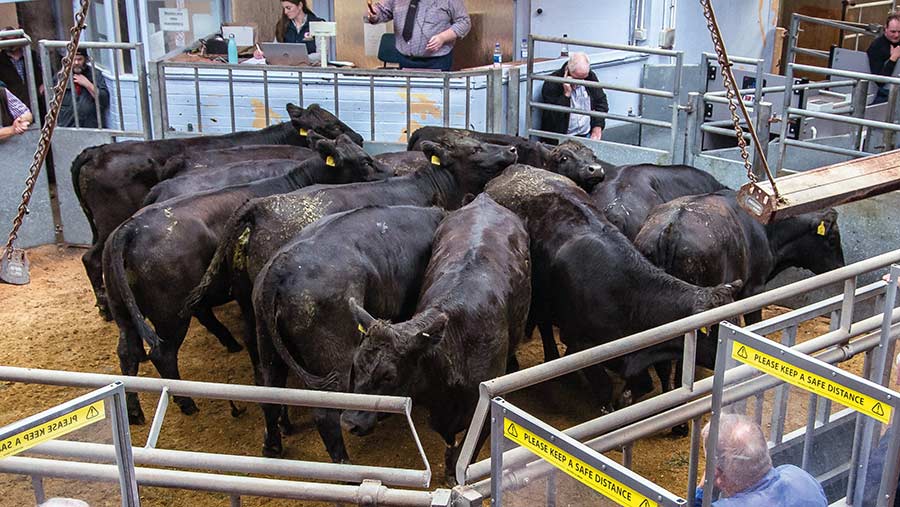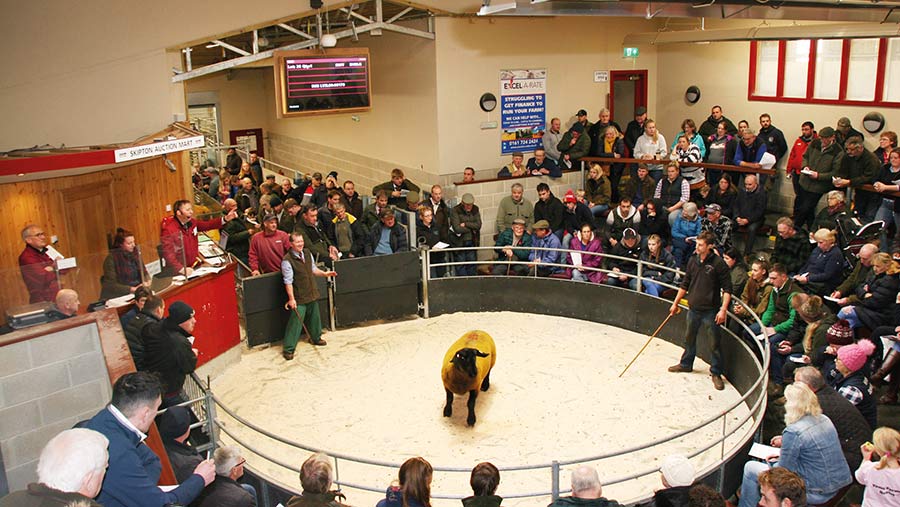Beef and lamb markets: Will record-breaking prices continue?
 © Robert Smith
© Robert Smith Farming has become much more expensive in the past 12 months, but will record-breaking prices continue to cover across-the-board inflation?
Rising input costs resulted from a hike in fuel prices, labour shortages, tight grain supplies and and a ten-fold increase in shipping container costs limiting global trade.
But tight cattle and sheep numbers have bolstered trade to record-breaking levels.
Famers Weekly asked farm consultant and economist Kev Bevan of K Bevan Consulting and the AHDB what key factors will drive the market in 2022.
See also: Beef prices match record high levels
Beef
Liveweight, finished continental bulls regularly grossed £2,000, and U-grade bulls going deadweight achieved prices of 425p/kg and above throughout 2021.
Best prime animals have regularly made 280-300p/kg liveweight and 410-420p/kg deadweight.
Suckled calf prices lifted again this autumn at many sale yards. Several sales saw prices 30p/kg up on the year and some early sales averaged 280-300p/kg.
However, the picture is a little varied, with some suckled calves looking “well bought”.
Older store cattle prices were sharply up on the year until October, when trade had a blip as finishers assessed rising costs amid a seasonal lift in cattle numbers.
Quality Meat Scotland averages for store steers at 12-18 months were £100 a head dearer on the year in late summer before trade dipped in the autumn. Prices have since recovered much of the lost ground.
Reasons to be cheerful
- Tight supply: Cattle supplies are tight in the UK and forecast to remain so in 2022
- Competition: High feed costs are hitting the poultry sector more than beef, so improving the relative competitiveness of beef
- Fake meat: Enthusiasm for meat alternatives has slowed as the naturalness of its production is scrutinised
Concerns
- Grass: A kind spring is essential for farms that are highly stocked and vulnerable to potentially low fertiliser availability (and exorbitant prices if available). Resting pastures over winter to build covers will be critical to maximising potential growth rates and N response rates
- Spring sales: If spring grass is tight, the important spring suckled calf and store sales will reflect this
- Winter 2022-23: Silage harvests will be light if less fertiliser is applied, which may force more young and breeding cattle onto the market in the autumn, lowering prices
- Suckler beef viability: Despite the welcome lift in cattle prices, suckler beef production generally remains unviable without support. The ebbing away of area payments in England will expose the vulnerability of suckler beef there and raise interest in dairy beef systems. With a small national dairy herd, dairy beef is less of an option in Scotland
- Dairy beef viability: The necessary high performance depends on the right genetics, healthy calves being given a good start, and a high proportion of growth coming off cheap grazed pasture. Integrated chains work best but don’t suit the mindset of some farmers
- Grading: The Europ grading system must evolve, and quickly, to encourage the type of finished cattle needed in future – cattle combining consistently high eating quality, a lower cost of production and environmental benefits
Things to watch
- Tough net-zero targets: In the next 10 years, British agriculture must cut its emissions by far more than it has achieved over the past 30 years. Without a change in how emissions are calculated at the farm level to better reflect reality, beef production will suffer because of its methane emissions
- Trading places: While British beef exports to the EU have been subject to checks since early 2021, imports from the EU have entered Britain freely. That changes in 2022, though Irish processors that provide most imports will handle the paperwork efficiently. Longer term, however, the Irish will be concerned about how new UK trade deals with the likes of Australia affect British imports
- Labour issues: Processors deserve high praise for keeping supply moving over the past year. Hopefully, Covid’s impact will lessen in 2022, but the staffing problems caused by Brexit may be more difficult to resolve
Lamb
The Great Britain SQQs have been at 218p/kg or above all year.
A 14-week period of liveweight average prices over 300p/kg led to farms drawing hard in the spring, a trend that has continued through much of the year.
Most lambs around 38kg have fetched £100 through the year, encouraging farmers to market light lambs.

© Moule Media
Strong Mule shearlings regularly hit £200 a head or more in the autumn, which tallies with the old saying that two prime lambs (at £100 a head) buys a shearling.
Kelso’s Texel shearlings lifted £437 a head on the last pre-Covid sale in 2019 to £1,412. Ram lambs were 46% dearer at £756 a head.
Long-keep store lambs at £80-£85 a head showed the level of confidence in the market and some finishers are doubling their money already on August/September-bought store lambs.
Reasons to be cheerful
- New Zealand (NZ) supply: NZ exports are limited (-16% to EU in 2021 to September). Global shipping difficulties and good Chinese demand means less competition from NZ this winter
- Lower-cost system: Sheep are less exposed to feed, fuel and fertiliser than beef thanks to their biology. Still, sheep producers will be hoping for a far better April and May than last year to take the pressure off feed and fertiliser spend
- 2022 crop size similar: A very kind autumn means ewes were tupped in good condition. Even if more lambs are kept there is no significant breeding flock increase predicted. Lambing weather is the next unknown factor in 2022 supply
Concerns
- Low kill to date: Are more lambs still out there than presumed? Long-keep store lamb buyers are more exposed if lamb availability is greater than expected. Thankfully, Ramadan, Easter and Eid al-Fitr should buttress demand in April through to early May
- Demand for lamb: With less opportunity to eat out because of Covid, lamb has benefitted from good retail demand. The supermarkets appear to have helped by absorbing much of the jump in farmgate price. But assuming a return to post-Covid market conditions, retail demand will be tested
- Standards: Much has been made of our superior standards in recent trade talks, but NZ lamb can boast high provenance following the introduction of tough environmental regulations and brand development. Important halal customers in UK/EU are more assured by NZ and Australian standards than ours
Things to watch
- EU market access: With about one-third of UK sheepmeat exported to the EU, any limitations to free-market access to Europe would see lamb prices take a sharp drop
- China: The growth in Chinese meat imports over the past decade has been extraordinary. But as the Australians found out, disagree with the Chinese and they stop trading with you. Some Australian lamb may come here eventually because of that fallout. Pray that NZ stays pals with the Chinese
- Scale: Commercial sheep farms will need to evolve to compete with antipodean imports. Running 1,500-1,800 cross-bred type ewes to a labour unit will need to become the norm, not the exception
- Soya: How successfully will this key protein be replaced in ruminant rations?
